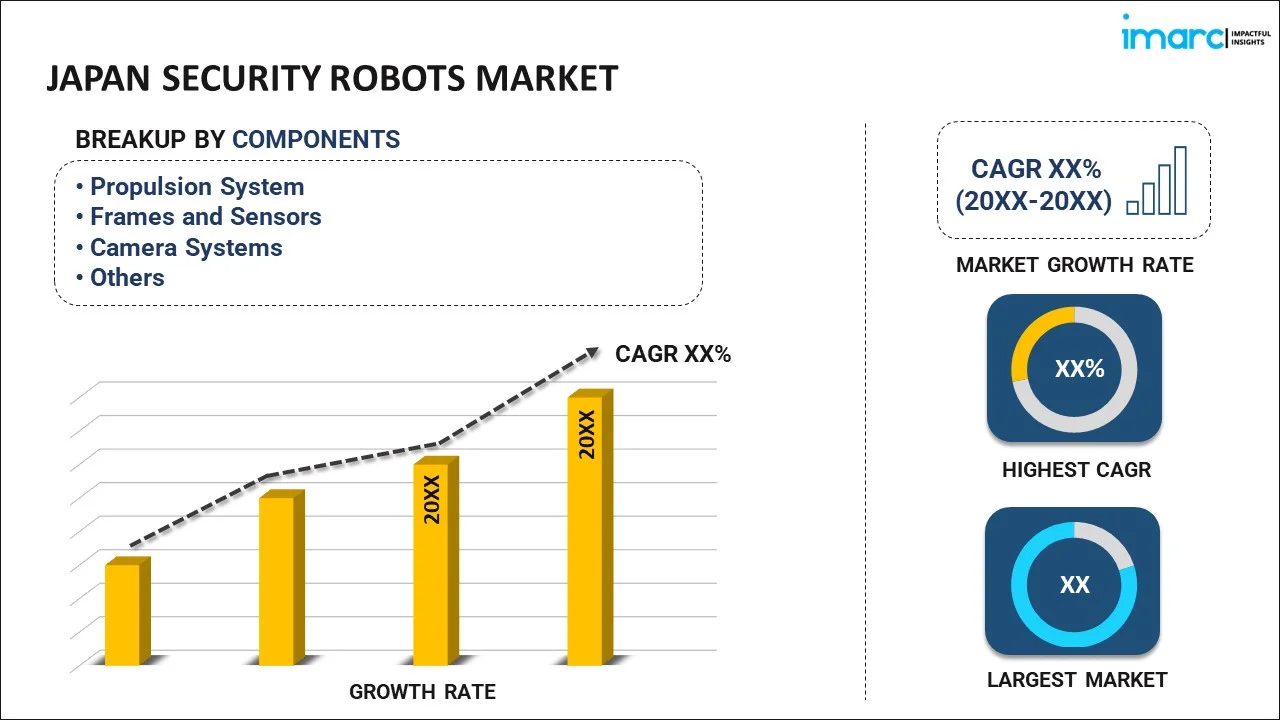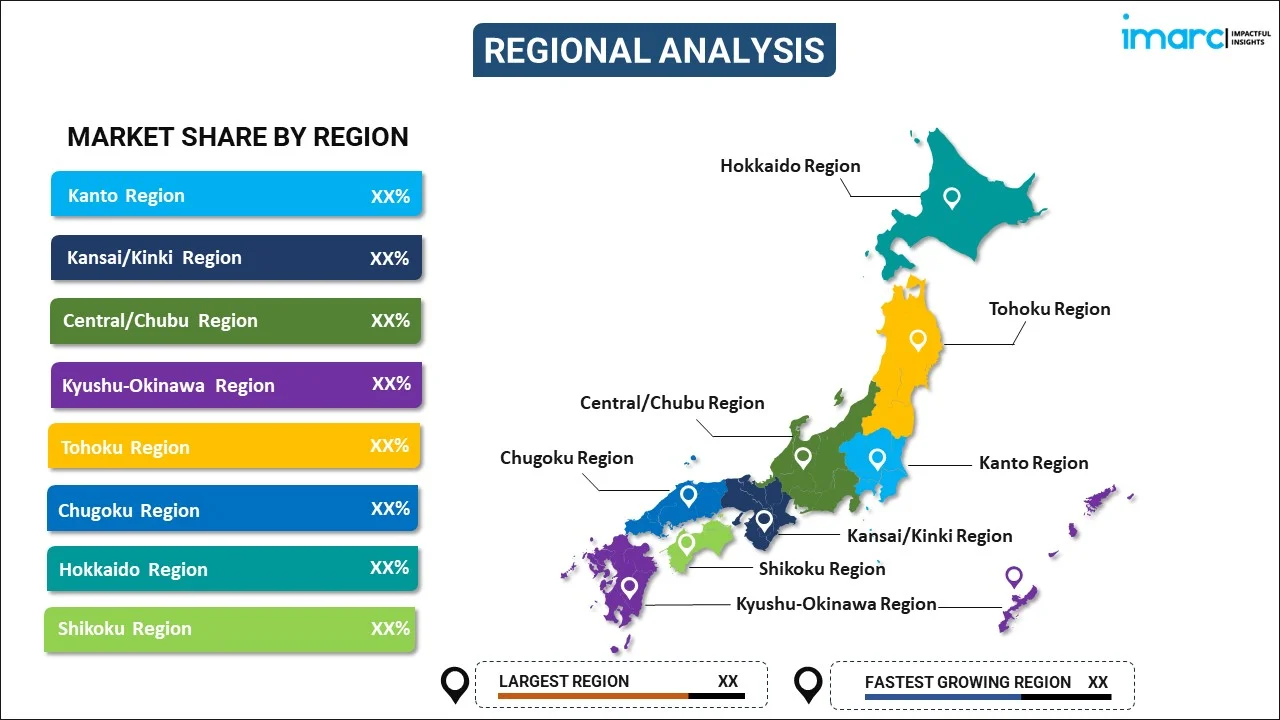
Japan Security Robots Market Report by Component (Propulsion System, Frames and Sensors, Camera Systems, Guidance and Navigation Control System, Power Systems, and Others), Type (Unmanned Ground Vehicle, Unmanned Aerial Vehicle, Autonomous Underwater Vehicle), Application (Spying, Patrolling, Explosive Detection, Rescue Operations, and Others), End User (Defense and Military, Residential, Commercial), and Region 2025-2033
Market Overview:
Japan security robots market size reached USD 878.1 Million in 2024. Looking forward, IMARC Group expects the market to reach USD 2,794.6 Million by 2033, exhibiting a growth rate (CAGR) of 13.7% during 2025-2033. The widespread adoption of advanced technologies, including neural networks, which help indoor robots in learning over time and improving their functionality, is primarily driving the market growth.
|
Report Attribute
|
Key Statistics
|
|---|---|
|
Base Year
|
2024 |
|
Forecast Years
|
2025-2033 |
|
Historical Years
|
2019-2024
|
| Market Size in 2024 | USD 878.1 Million |
| Market Forecast in 2033 | USD 2,794.6 Million |
| Market Growth Rate (2025-2033) | 13.7% |
Security robots are autonomous security agents that utilize artificial intelligence (AI), live video streaming, and interconnected technologies to carry out surveillance and security-related functions. These robots come equipped with high-definition (HD) cameras, electric motors, and advanced, high-capacity batteries. Moreover, they play a crucial role in tasks like reporting, monitoring, investigating, identifying intruders, and conducting patrols in designated surveillance zones. Due to their dependability, resistance to corruption, and cost-effectiveness when compared to human security guards, security robots find widespread applications in various settings, including shopping malls, parking facilities, and educational institutions such as schools and campuses. As a result, they are gaining traction in Japan.
Japan Security Robots Market Trends:
The security robots market in Japan is experiencing a favorable growth trajectory, driven by the escalating security concerns among individuals and the increasing adoption of automation technologies. This growth is further amplified by substantial government investments in defense due to growing geopolitical tensions among neighboring nations and the rising threat of terrorism. Apart from this, the widespread deployment of security robots in locations like shopping malls, parking lots, and educational campuses for the purpose of alerting security personnel about potential threats or criminal activities is also contributing significantly to market expansion. Furthermore, manufacturers in Japan are also incorporating advanced technologies such as neural networks and deep learning models to enhance the functionality of these robots over time, further boosting the market growth. Besides this, the integration of automation capabilities in security robots designed for challenging terrains and environments, enabling them to perform surveillance and other analytical-based actions, is a significant driver for market growth. Additionally, the increasing trend of indoor robots offering safety and commercial benefits, coupled with extensive research and development (R&D) activities in the field, are anticipated to further propel the security robots market in Japan over the forecasted period.
Japan Security Robots Market Segmentation:
IMARC Group provides an analysis of the key trends in each segment of the market, along with forecasts at the country level for 2025-2033. Our report has categorized the market based on component, type, application, and end user.
Component Insights:

- Propulsion System
- Frames and Sensors
- Camera Systems
- Guidance and Navigation Control System
- Power Systems
- Others
The report has provided a detailed breakup and analysis of the market based on the component. This includes propulsion system, frames and sensors, camera systems, guidance and navigation control system, power systems, and others.
Type Insights:
- Unmanned Ground Vehicle
- Unmanned Aerial Vehicle
- Autonomous Underwater Vehicle
A detailed breakup and analysis of the market based on the type have also been provided in the report. This includes unmanned ground vehicle, unmanned aerial vehicle, and autonomous underwater vehicle.
Application Insights:
- Spying
- Patrolling
- Explosive Detection
- Rescue Operations
- Others
The report has provided a detailed breakup and analysis of the market based on the application. This includes spying, patrolling, explosive detection, rescue operations, and others.
End User Insights:
- Defense and Military
- Residential
- Commercial
A detailed breakup and analysis of the market based on the end user have also been provided in the report. This includes defense and military, residential, and commercial.
Regional Insights:

- Kanto Region
- Kansai/Kinki Region
- Central/ Chubu Region
- Kyushu-Okinawa Region
- Tohoku Region
- Chugoku Region
- Hokkaido Region
- Shikoku Region
The report has also provided a comprehensive analysis of all the major regional markets, which include Kanto Region, Kansai/Kinki Region, Central/ Chubu Region, Kyushu-Okinawa Region, Tohoku Region, Chugoku Region, Hokkaido Region, and Shikoku Region.
Competitive Landscape:
The market research report has also provided a comprehensive analysis of the competitive landscape. Competitive analysis such as market structure, key player positioning, top winning strategies, competitive dashboard, and company evaluation quadrant has been covered in the report. Also, detailed profiles of all major companies have been provided. Some of the key players include:
- Secom Co. Ltd.
- SMP Robotics Systems Corp.
- Sohgo Security Services Co. Ltd. (ALSOK)
(Please note that this is only a partial list of the key players, and the complete list is provided in the report.)
Japan Security Robots Market Report Coverage:
| Report Features | Details |
|---|---|
| Base Year of the Analysis | 2024 |
| Historical Period | 2019-2024 |
| Forecast Period | 2025-2033 |
| Units | Million USD |
| Scope of the Report | Exploration of Historical Trends and Market Outlook, Industry Catalysts and Challenges, Segment-Wise Historical and Future Market Assessment:
|
| Components Covered | Propulsion System, Frames and Sensors, Camera Systems, Guidance and Navigation Control System, Power Systems, Others |
| Types Covered | Unmanned Ground Vehicle, Unmanned Aerial Vehicle, Autonomous Underwater Vehicle |
| Applications Covered | Spying, Patrolling, Explosive Detection, Rescue Operations, Others |
| End Users Covered | Defense and Military, Residential, Commercial |
| Regions Covered | Kanto Region, Kansai/Kinki Region, Central/ Chubu Region, Kyushu-Okinawa Region, Tohoku Region, Chugoku Region, Hokkaido Region, Shikoku Region |
| Companies Covered | Secom Co. Ltd., SMP Robotics Systems Corp., Sohgo Security Services Co. Ltd. (ALSOK), etc. |
| Customization Scope | 10% Free Customization |
| Post-Sale Analyst Support | 10-12 Weeks |
| Delivery Format | PDF and Excel through Email (We can also provide the editable version of the report in PPT/Word format on special request) |
Key Questions Answered in This Report:
- How has the Japan security robots market performed so far and how will it perform in the coming years?
- What has been the impact of COVID-19 on the Japan security robots market?
- What is the breakup of the Japan security robots market on the basis of component?
- What is the breakup of the Japan security robots market on the basis of type?
- What is the breakup of the Japan security robots market on the basis of application?
- What is the breakup of the Japan security robots market on the basis of end user?
- What are the various stages in the value chain of the Japan security robots market?
- What are the key driving factors and challenges in the Japan security robots?
- What is the structure of the Japan security robots market and who are the key players?
- What is the degree of competition in the Japan security robots market?
Key Benefits for Stakeholders:
- IMARC’s industry report offers a comprehensive quantitative analysis of various market segments, historical and current market trends, market forecasts, and dynamics of the Japan security robots market from 2019-2033.
- The research report provides the latest information on the market drivers, challenges, and opportunities in the Japan security robots market.
- Porter's five forces analysis assist stakeholders in assessing the impact of new entrants, competitive rivalry, supplier power, buyer power, and the threat of substitution. It helps stakeholders to analyze the level of competition within the Japan security robots industry and its attractiveness.
- Competitive landscape allows stakeholders to understand their competitive environment and provides an insight into the current positions of key players in the market.
Need more help?
- Speak to our experienced analysts for insights on the current market scenarios.
- Include additional segments and countries to customize the report as per your requirement.
- Gain an unparalleled competitive advantage in your domain by understanding how to utilize the report and positively impacting your operations and revenue.
- For further assistance, please connect with our analysts.
 Inquire Before Buying
Inquire Before Buying
 Speak to an Analyst
Speak to an Analyst
 Request Brochure
Request Brochure
 Request Customization
Request Customization




.webp)




.webp)












